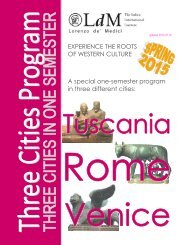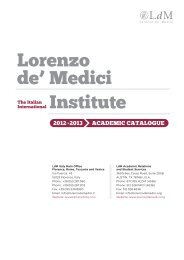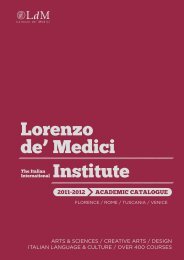aCademiC Catalog 2013-2014 - Lorenzo de Medici
aCademiC Catalog 2013-2014 - Lorenzo de Medici
aCademiC Catalog 2013-2014 - Lorenzo de Medici
You also want an ePaper? Increase the reach of your titles
YUMPU automatically turns print PDFs into web optimized ePapers that Google loves.
FLORENCE<br />
School of Arts & Sciences<br />
The Holocaust: Jewish and Christian<br />
Responses<br />
PHR 240 F; Dual listed: HIS 235 F<br />
Cr: 3; Contact hrs: 45<br />
This course is an introduction to the legacy of the Holocaust<br />
and its religious implications. The course explores Christian<br />
anti-Judaism as one of many factors in the Nazi rise to power<br />
and the “Final Solution”. It then proceeds to various accounts<br />
of life in the Nazi ghettoes and <strong>de</strong>ath camps and <strong>de</strong>als with<br />
Christian and Jewish efforts to remember the Holocaust within<br />
particular communities and places. The course will focus on<br />
the Holocaust of the Italian Jews. It will begin with an analysis<br />
of the emergence of the Fascist movement in Italy, which lead<br />
to the Racial Laws. It will proceed with the study of specific<br />
stories of persecution, <strong>de</strong>portation and salvation in the various<br />
cities of Italy. We will study in <strong>de</strong>pth the reaction of the Vatican<br />
to the Holocaust. In addition we will analyze the reactions of<br />
Italian society, starting right after the war up until today, to the<br />
Holocaust.<br />
Mysteries and Sacred Knowledge in<br />
Architecture<br />
PHR 243 F; Dual listed: ART 243 F<br />
Cr: 3; Contact hrs: 45<br />
This course explores the architecture of various past cultures<br />
relative to their belief systems, and links this to contemporary<br />
practice. It reads buildings and spaces as the products of<br />
diverse forms of special sacred knowledge or wisdom, whose<br />
language can be reconstructed, un<strong>de</strong>rstood, and enjoyed. Key<br />
themes inclu<strong>de</strong>: esoterism; concepts of harmony, proportion<br />
and geometry; numerology; astrology and cosmology; the<br />
architect as creator; symbolism; ornament. Cultures examined<br />
inclu<strong>de</strong> ancient Egypt, classical antiquity (Greece and Rome),<br />
ancient India (vaastu), ancient and mo<strong>de</strong>rn China (feng shui),<br />
medieval, Renaissance and Enlightenment Europe. From the<br />
proportions of a pyramid to a freemason’s lodge, from the<br />
capitals of a cathedral to the planning of a resi<strong>de</strong>nce or square<br />
in ancient or Renaissance Rome, the course seeks common<br />
elements that may connect all cultures. Stu<strong>de</strong>nts discover new<br />
interpretative keys that offer profound perspectives on the art<br />
and craft of architecture, from antiquity to today.<br />
Archaeology of Religion: Death and Ritual in<br />
the Past<br />
PHR 252 F; Dual listed: CLA 252 F / ANT 252 F<br />
Cr: 3; Contact hrs: 45<br />
Religion is based on a combined system of beliefs and practices<br />
that allows people to answer fundamental questions regarding<br />
human life. What can archaeology tell us about religion? The<br />
course explores key questions regarding the role and evolution<br />
of religious beliefs and practices by systematically analyzing<br />
the archaeological remains of ancient religious material culture<br />
across the Mediterranean and the Ancient Near East, between<br />
the prehistoric and early classical periods. Direct links between<br />
religious practices and beliefs are strongly evi<strong>de</strong>nt in ancient<br />
societies, where the construction of large physical structures<br />
(such as temples) appears to be pivotal in the evolution<br />
of mankind. Stu<strong>de</strong>nts learn to use archaeological data and<br />
historical sources for the period. They address broad theoretical<br />
and methodological issues, explore how architecture was used<br />
by ancient societies in creating their cosmological landscape,<br />
and evaluate interpretations of the first appearance of family<br />
ancestor cults. The first part of the course treats theoretical<br />
and methodological issues in the study of religious thought,<br />
while the second part reinforces un<strong>de</strong>rstanding through close<br />
analysis of ancient written sources, architecture, and other<br />
examples of material culture.<br />
Prerequisites: one previous course in History of Religions,<br />
Cultural Anthropology, Archaeology<br />
The Catholic Church and Society in Italy<br />
PHR 254 F; Dual listed: HIS 254 F<br />
Cr: 3; Contact hrs: 45<br />
Over the centuries the Catholic Church has had a major<br />
impact on Italian society, and its beliefs and traditions form a<br />
central part of mo<strong>de</strong>rn Italian culture. This course explores the<br />
interaction of religion and society in Italy over a long period,<br />
beginning with the birth of Christianity, and moving onto early<br />
<strong>de</strong>velopments in Latin Roman times, the Middle Ages, the<br />
Renaissance, the Reformation and Counter Reformation, up to<br />
contemporary issues in the present day.<br />
Prerequisites: HIS 130 Western Civilization, or PHR 210 World<br />
Religions, or equivalents<br />
Lost Symbolisms: Secret Co<strong>de</strong>s in Western<br />
Art<br />
PHR 255 F; Dual listed: ART 255 F<br />
Cr: 3; Contact hrs: 45<br />
The course focuses on the links between artworks and astrology,<br />
alchemy, geometry, numerology, and selected philosophical<br />
themes in Western art between 1300 and 1800. Art has served<br />
various functional and aesthetic purposes in different cultures<br />
and periods. In some eras art has also embodied a symbolic<br />
language, mysterious to the majority but highly significant to<br />
the minority able to read or <strong>de</strong>co<strong>de</strong> it. For example, what we<br />
may call the secret messages of certain paintings and sculptures<br />
of past centuries can be interpreted in terms of astrology.<br />
A specific field of art history, iconography, studies subject<br />
matter, symbolism, and signification in works of art. Stu<strong>de</strong>nts<br />
use elements of this approach to examine the fascinating and<br />
complex range of meanings that some artworks were inten<strong>de</strong>d<br />
to transmit and which can still be recovered.<br />
From Plato to Machiavelli: Classical Political<br />
Thought<br />
PHR 260 F; Dual listed: POL 260 F<br />
Cr: 3; Contact hrs: 45<br />
The course examines the evolution of that branch of<br />
philosophical thought that gave birth to the mo<strong>de</strong>rn concept of<br />
political science and political thinking, exploring major periods<br />
and personalities in the <strong>de</strong>velopment of political thought. It<br />
thus covers a very long historical period from the time of the<br />
“dawn” of Western philosophy to the most relevant issues of<br />
the mo<strong>de</strong>rn era. Emphasis will be placed first on the Gol<strong>de</strong>n<br />
Age of Greek-Athenian <strong>de</strong>mocracy, through the analysis of<br />
thinkers such as Plato and Aristotle; then, the course will move<br />
on to the main philosophical schools of the Middle Ages (the<br />
Scholastics) through the analysis of authors such as Thomas<br />
Aquinas, Dante and Ockham. Stu<strong>de</strong>nts will then encounter<br />
the extraordinarily rich period of the Italian and European<br />
Renaissance, both as a vast cultural revolution and as a cradle<br />
of new i<strong>de</strong>as and thought systems: the personalities and works<br />
of Thomas More, Machiavelli and Erasmus will be carefully<br />
studied, without un<strong>de</strong>restimating the importance of the rising<br />
i<strong>de</strong>as of Luther and Calvin. Finally, the course will investigate<br />
the early mo<strong>de</strong>rn adaptations of these thought systems as<br />
manifested in the rationalism of Hobbes.<br />
Prerequisites: PHR 130 Western Philosophy, or POL 150<br />
Introduction to Political Science, or equivalents, or sophomore<br />
standing<br />
From Machiavelli to the present: Mo<strong>de</strong>rn<br />
Political Thought<br />
PHR 265 F; Dual listed: POL 265 F<br />
Cr: 3; Contact hrs: 45<br />
This course will analyze some landmarks of the western<br />
philosophical tradition. Its aim is to discuss concisely the views<br />
of some major Western political thinkers in or<strong>de</strong>r to <strong>de</strong>monstrate<br />
how their i<strong>de</strong>as about politics and society are critical to<br />
un<strong>de</strong>rstanding the politics of our time. The course aims to<br />
analyze on the one hand the philosophies and i<strong>de</strong>as that have<br />
been sustaining our present world view, and on the other hand<br />
the roots of some recurrent key themes in these philosophies,<br />
such as the i<strong>de</strong>a of utopia, as well as the anti-utopian vision<br />
whose originator can be consi<strong>de</strong>red Niccolò Machiavelli. This<br />
last theme thus introduces stu<strong>de</strong>nts to the reaction against<br />
the so-called “Platonic i<strong>de</strong>al” that has taken place during the<br />
twentieth century. The concept of totalitarianism is related to<br />
these pivotal philosophical perspectives and this concept will<br />
also be studied with particular attention. More specifically,<br />
special emphasis will be placed on the analysis of a series of<br />
concepts connected to one another, including the concept<br />
of liberty; relativism versus pluralism; freedom, equality and<br />
fraternity. The course is structured as a chronological analysis<br />
76<br />
LdM Aca<strong>de</strong>mic <strong>Catalog</strong> <strong>2013</strong>-<strong>2014</strong>





